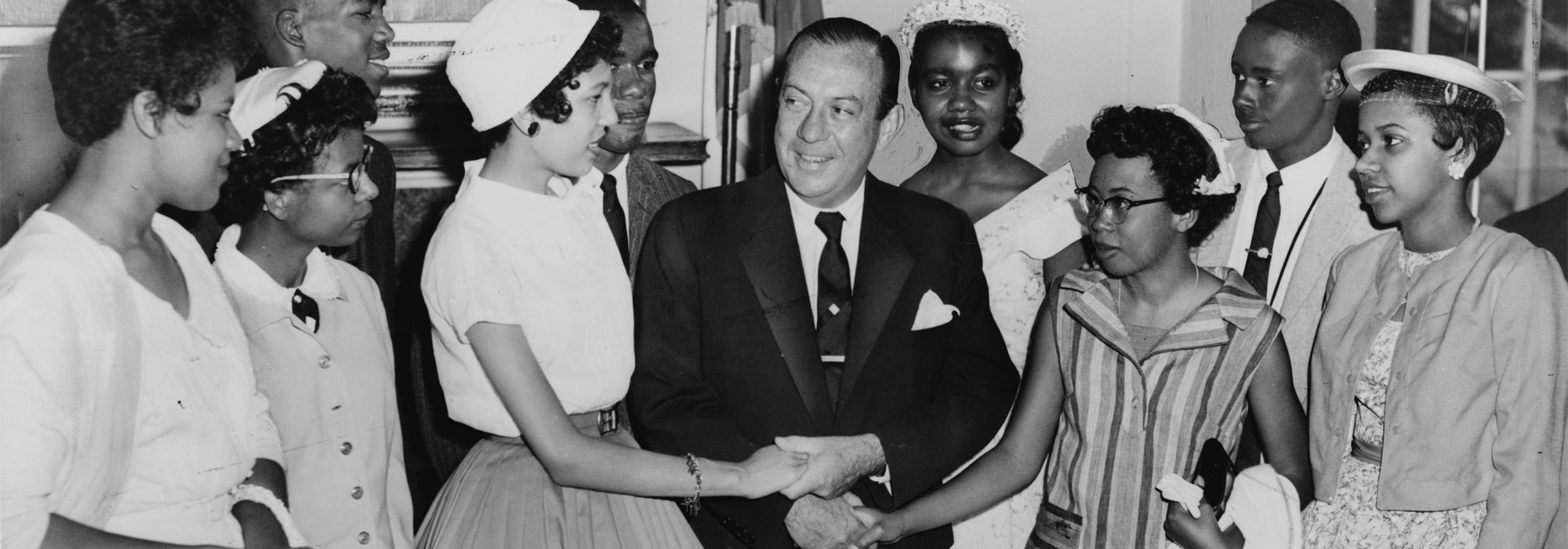
New York City Mayor Robert Wagner greeting the teenagers who integrated Central High School, Little Rock, Arkansas. Courtesy of the Library of Congress, New York World-Telegram & Sun Collection, LC-USZ62-125125.
Minnijean Brown, Elizabeth Eckford, Carlotta Walls, Mayor Wagner, Thelma Mothershed, Gloria Ray, Terrance Roberts, Ernest Green, Melba Pattilo, Jefferson Thomas.
On September 23, 1957 in Little Rock, Arkansas, these nine African-American students quietly slipped into Central High School through the side door with the assistance of the city’s police, while an angry white mob numbering 1,000 swarmed the front of the school to await their arrival. Upon learning of their entry, the crowd became unruly, confronting and overwhelming the city police. During the riot, two African-American journalists were physically harassed and attacked and then chased out of the area. School windows and doors were broken and the nine African-American students were escorted out of the school by police. Fearful of what may happen, the school administration had the Black students escorted out a side door. Central High School’s integration efforts that day—which started in 1955 with the school board voting to gradually integrate—came to a quick close, all before lunch.
On September 25, 1957, under escort by the soldiers of the 101st Airborne Division, the nine Black students were escorted back into Central High. The brave efforts of the students, later known as the "Little Rock Nine," to gain equal access to education in the United States, established September 25th as an important date in the Nation and in the Civil Rights Movement.
After that fateful day the "Little Rock Nine" integrated Central High School, the U.S. Supreme Court contributed to advancements toward school integration, from such decisions as those in Cooper v. Aaron (1958) which overrode state government’s ability to block desegregation, to Keyes v. Denver School District No. I (1963) which established the right to desegregation outside the South and the right of desegregation for Latino students. As a result of such key court-ordered desegregation requirements, for the next three decades, school districts across the country implemented plans to desegregate their student bodies.
By the 1990s, most once-segregated schools had desegregated in accordance with the law, and thus fewer desegregation orders were deemed necessary by the courts. Unfortunately, however, the courts’ decisions, in addition to existing residential housing patterns, have led to an increase of de facto segregation. For example, at its peak of integration in 1988, 44% of Black southern students were in majority-white schools, the kind of schools that provided strong potential opportunities for diverse learning experiences. By 2011, that number had declined to 23%, a drop by nearly half, and the decline has accelerated in recent years. The percentage of students in majority white schools is lower than it was in 1968. In addition, while white students are attending schools with slightly more students of color than in the past, they remain the most isolated of all racial groups. The average white student attends a school where 72.5% of the student enrollment is white.1
In addition to court-mandated plans, voluntary integration plans—plans implemented by schools rather than mandated by the courts to address de facto segregation—have also been under attack. In June 2007, the Supreme Court struck down two voluntary integration plans, one implemented in Seattle and the other in Louisville. Even though the decision confirmed that the government had a compelling interest in promoting racial diversity, the Court’s decision finding the plans unconstitutional placed limits on the ability of school districts to take account of race but it did not rule out any consideration of race in student assignment. This left the window open for school districts to take race-conscious measures to promote diversity and avoid racial isolation in schools. But, this has discouraged some school districts from creating any integration plans, and may make racial isolation in our nation’s schools an inevitability. After the court's decision, the Seattle school board declined to find alternate routes to integration, citing residential segregation as a barrier. The Seattle school board chairwoman told The Seattle Times, “It’s not my job to desegregate the city.”
School resegregation is on the rise, marked by factors such as changing racial demographics, redrawn school boundaries, new student-assignment plans, budget cutbacks and other factors.
The U.S. population is more racially diverse than ever before. Many school districts recognize the value of racial and ethnic diversity and its important influence on educating our future citizens. Skills in working and living successfully in a multiracial society and in multiracial institutions are a vital asset.



1Orfield, Gary, and Frankenberg, Erica. 2014. "Brown at 60: Great Progress, a Long Retreat and an Uncertain Future." Los Angeles, CA: The Civil Rights Project.